In order to know ‘how’ to rewire the brain to manage chronic pain, first we need to understand ‘what’ pain and neuroplasticity even are. Let’s take a closer look at their definitions and causations to begin with.
*Note: Whilst this post is sponsored by Pathways, all opinions expressed are my own. I am also not a doctor, but the article is based on meticulous research from credible sources. Nothing should be taken as medical advice. Always be sure to check with your doctor before you start on any new treatment or protocol.
Post Updated: 02 April 2021
You Can Now Listen to the Post on the Podcast Here!
Pin to Your Chronic Pain Management Boards:

Table of Contents
What is Pain?
Acute vs Chronic Pain
At its most basic level, there are two classifications of pain – acute and chronic – where chronic is defined as anything that lasts for more than three months.
Our brains dedicate about five per cent of neurons in a particular area to process acute pain. Compare this to chronic pain, where the numbers are much higher at 15 – 25 per cent, due to the constant firing that wires these neurons together.
Pain isn’t always bad and has its uses as a form of protective mechanism. The brain itself contains no pain nerves, and it is our body that sends danger signals to it as feedback. The brain then interprets and translates them into pain which we feel.
The Different Sources of Pain
Pain can stem from different sources, such as inflammation, central sensitisation, emotions, and can even be of a psychosomatic nature.
No matter the root cause, the pain felt is very real, with drastic loss in a person’s quality of life. Nothing in our bodies are standalone, and that includes mental and physical health.
A pain cycle builds up over time if the pain does not go away. We then learn to fear this pain, or develop more problems that feed off it.
Pin to Your Chronic Pain Boards:


An Animation on the Pain Cycle
This animation sums it up in a nice and simple way. You can also view the comprehensive infographic of the pain cycle here.
What is Neuroplasticity?
Neuroplasticity is still a new field in medicine, and is more of an umbrella term used to describe adaptation and changes to the brain.
There are two types of neuroplasticity. Functional plasticity is the brain’s ability to move functions from a damaged area to other parts within it. Structural plasticity is the brain’s ability to change its physical structure by learning.
This can be both a good and bad thing. These changes in the brain manifest through the formation of new connections between neurons. This can reinforce either negative or positive thought patterns, bad or good habits. It can also amplify pain, or dial it down.
A Bit More About the Brain, and What Neuroplasticity has Got to Do with It
The Various Parts of the Brain & What They Do
Various parts of our brain excel in different functions:
- Amygdala – Processes emotions, and triggers the fight or flight response.
- Hippocampus – Processes memories and regulates emotions.
- Frontal lobe – Decision making functions.
- Cerebellum – Coordinates movement.
- Parietal & Temporal lobes – Processes new sensory information.
- Dopamine, serotonin & melatonin – Perform a wide variety of functions, but are all made out of the same elements (hydrogen, oxygen & nitrogen).
Grey matter is the mass of neuronal cells involved in processes such as memory, speech and muscle control. White matter tracts are bundles of myelinated axons, which relay sensory information from the muscles and skin to the brain. They are interdependent and form ‘pathways’ to the various compartments in our brains.
‘Rewiring’ Our Neuronal Pathways
These neuronal pathways ‘light up’ every time we think, feel, or do something. Over time, these pathways become stronger based on our thoughts and actions. We can work on improving the ‘stamina’ of these pathways, which helps to increase the speed of transmission between sensory input and brain output.
A good example of this can be seen in stroke patients, who often need to relearn how to do basic activities such as walking. This is usually done under the guidance of a physiotherapist, where they practice these motions on repeat over many sessions.
We can also work on decreasing negative input, or attempt to break the pain cycle, by teaching our brains that the danger signals it receives are not a hundred per cent accurate.
A classic example of this can be seen in Allodynia, where even a light breeze can cause extreme pain to the sufferer. One of the coping methods used is ‘graded desensitisation’; this exposes the patient to the cause of the pain itself at a gradual pace, in an attempt to desensitise the sensation.
Pin to Your Chronic Pain & Neuroplasticity Boards:
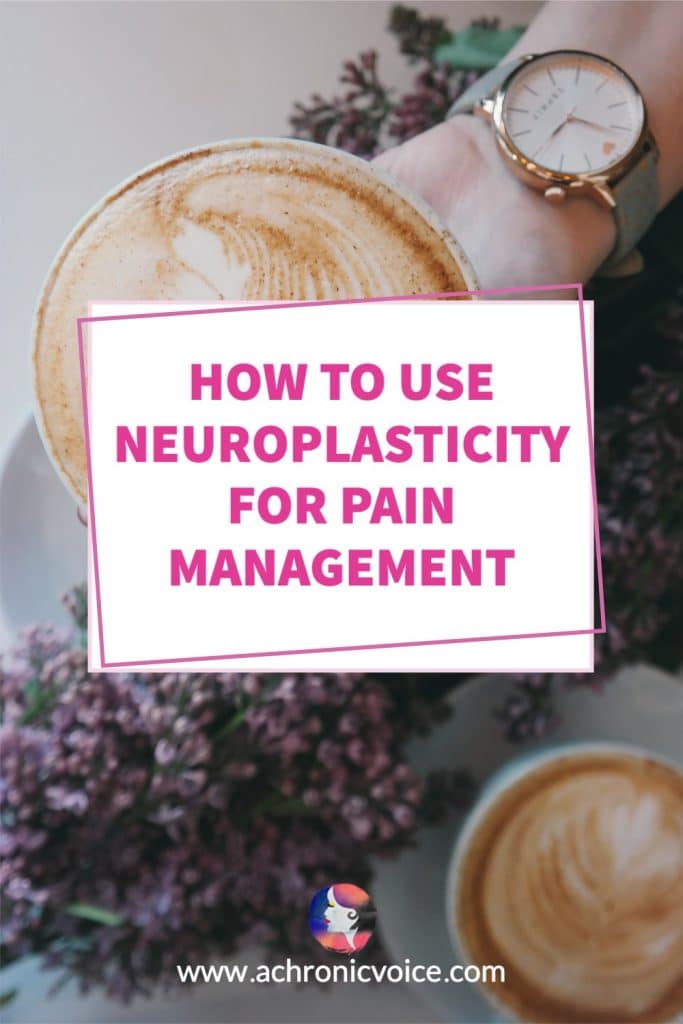
Central Sensitisation & Types of Chronic Pain
The circuits in a chronic pain patient’s brain tend to be abnormal. This is especially true when it comes to central sensitisation, which affects the nervous system directly.
Pain isn’t just ‘pain’ – to the patient and doctor, details matter in order to find a solution and relief. For example, it could be of a neuropathic, radicular, somatic, myofascial, visceral, or inflammatory nature.
When Pain Becomes Encoded Into the Brain Itself
Chronic pain from central sensitisation happens when pain is encoded into the brain itself. There is no real cause for it – neither injury nor inflammation. Rates for central sensitisation vary from 10 per cent in shoulder pain, to 100 per cent in fibromyalgia.
It also affects many other conditions such Phantom Limb pain, a devastating condition where amputees feel extreme pain in the areas that are ‘no more’. How is that even possible, when nothing physical exists there to feel the pain?
Repetitive Strain Injury (RSI) is caused by repetitive movement and overuse, and can affect the muscles, nerves and tendons. Sandip, the founder of the Pathways Pain Relief app himself, suffered from such bad RSI that he could hardly turn the page of a book without extreme pain. He was desperate to the point where he considered learning how to type with his toes.
Central Sensitisation & The Creation of Pain Cycles
In central sensitisation, the brain is using its memory compartment to ‘learn’ pain. Treatment therefore involves unlearning this pattern. There are medications and nerve treatments that work on our memories, but we can also unlearn these patterns and reduce these pathways through neuroplasticity.
No matter what the cause of chronic pain is, it ends up feeding back into the pain cycle. This triggers a cascade of emotional and mental side effects, which can trigger yet more pain.
It is a vicious cycle that needs to be broken and rewired. In Sandip’s case, the root cause of his pain stemmed from central sensitisation, and he was able to become pain-free over time through the practice of neuroplasticity.
Pin to Your Chronic Pain Boards:

Everyday Activities That Can Modify the Brain
It might surprise you, but many activities that we already do in our daily lives involve neuroplasticity. It really isn’t such a foreign concept!
- Exercise.
Exercise influences the survival and maturation of adult born neurons, and increases neurogenesis (the growth of new neurons).
- Sleep.
Sleep is essential for the removal of waste within our brains. A lack of it impacts neurogenesis and cognitive function. One of its neuroprotective mechanisms is to reduce inflammation associated with aging, which can result in diseases such as Parkinson’s Disease.
- Diet.
Diets and intermittent fasting can increase synaptic adaptation, promote neuron growth, improve cognitive function, and decrease the risk of neurodegenerative diseases.
- Creative Pursuits.
The creation of art, dance and reading fiction are other interesting ways to enhance connectivity within the brain.
- Music.
Music is perhaps one of the most powerful methods to alter the brain, as it requires simultaneous usage of several areas. Both audiovisual information as well as the appreciation of abstract rules are required. Some studies have even found that the brain structures of trained musicians differ from others.
Binaural beats is a neuroplasticity technique that requires you to listen to relaxing music that plays different tones in separate ears. This triggers a positive response in the brain, and can lead to to better cognitive function.
Pin to Your Neuroplasticity & Infographics Boards:
6 Ways to ‘Rewire’ Your Brain to Manage Chronic Pain
Here are a few simple techniques and useful resources to get you started:
1. Mindfulness Meditation
Mindfulness meditation is a natural way to increase grey matter, and also slows down atrophy of the brain. Several areas of the brain become larger after meditation, such as the hippocampus and amygdala, which regulates the fight or flight response. Research also shows that it could have the same anti-inflammatory response as medications, especially for experienced meditators.
2. Human Connection
As human beings, we are also wired to seek out social connections. A rich social network of both meaningful relationships and affectionate love are stimulatory, and encourages healthy aging.
3. Food & Supplements
Our brains may only weigh two per cent of our body weight, yet it consumes twenty per cent of energy derived from nutrients. This demand stems from the neurons’ need to function properly.
Certain supplements and foods have neuroprotective effects on our brains. In particular, compounds found in many fruits, vegetables, tea, wine, herbs and omega-3 fatty acids. These compounds can modulate synaptic plasticity by altering neurogenesis, inflammation, and antioxidant defenses.
4. Psychotherapy & CBT
Psychotherapy is often used to switch negative thought patterns into positive ones. Cognitive Behavioural Therapy (CBT) involves both changes in our thoughts and actions. A common method in CBT is graded exposure. Like its name says, it is a process where the therapist guides the patient, slowly exposing them to their fear. The end goal is to replace the negative thoughts with positive ones instead.
5. Neurosculpting
Neurosculpting is a trademarked five step process founded by Lisa Wimberger. It fuses the latest research in neuroscience with a guided meditation.
We often find something stressful because we have made negative associations with it. Our brain then assesses these experiences and compartmentalises them. It classifies them as threats, in order to protect us in future.
Neurosculpting aims to remap these associations in our brains, which are most likely not totally accurate. The steps are as follows:
- Engage Your Parasympathetic (Rest and Digest) Response
Down regulate hypervigilance and stress triggers. Tell your brain that all is safe and well.
- Activate the Prefrontal Cortex (Our Brain’s Seat of Compassion & Empathy)
You can only do this once your brain has calmed down. Now what it needs are resources to access its centre. Some techniques to exercise this part of your brain is to do everyday activities with a twist.
For example, brushing your teeth or hair with your non-dominant hand. It can even be fictitious, such as imagining what it’d be like to have a tail, or to walk with three legs instead of two.
For those who meditate, these resources tend to be easier to access within your brain.
- Increase the Activity Between the Logical & Emotional Brain
Once you are at this stage, you are at the crux of focussed attention. You can then access and edit a memory, whilst calming your fight or flight response.
Use this moment to tell yourself a new and more positive story. Increase the plasticity between your left and right brain hemispheres using concrete details, semantic, abstract colours and imagery.
- Imprint the Meditation
Do a body scan – where do you hold the most tension when you think about the negative subject in particular?
Notice it; the next time this same tension arises, touch that spot. See if that helps to remind you of the new, positive association you have assigned to it.
- Name the Meditation
Complete the whole neurosculpting process by giving it a name. Use linguistic references as cues to invoke your brain’s natural pattern-forming inclination.
As Wimberger illustrates, it is like going over a light pencil sketch over and over again, until a solid, beautiful picture forms.
6. Digital Resources
There are many courses on neuroplasticity out there, on free platforms such as YouTube, or paid ones like Udemy. As always, quality makes a big difference. It is always a good idea to do your research on the lecturer, course materials, and also understand your own learning style.
The Pathways App & Its 5 Main Modules
Pathways is another great digital resource on neuroplasticity. Sandip was a pain patient himself, so he understands what it feels like to be in constant pain, and how neuroplasticity can indeed work to manage it.
It is currently the most comprehensive online pain therapy programme out there. The five main modules are:
- Pain Relief Essentials
- Supercharge Pain Relief
- Deep Stress Relief
- Happiness & Gratitude
- Mindfulness & Meditation
Within each module are many physical and visualisation exercises, educational material, quizzes and more. Laid out in a step by step plan, each session is digestible and easy to follow.
I liked that there was a transcript for each session, although it is a good idea to pause whatever you are doing, and listen to the audio. This will help the information to sink in a little deeper.
The Pathways app provides all the tools and information you need to get started on rewiring your brain in a positive way. Its ultimate aim and wish is that the power of neuroplasticity can be harnessed to manage your chronic pain.
Pin to Your Pain Management & Infographics Boards:
An Accountability Partner Can be Helpful
Whatever you choose to do, finding an accountability partner can be helpful. You can both encourage each other to work towards a better quality of life, especially when one of you is feeling down.
I wish you all the best in your experimentation and journey to better health. I know that I will be trying these methods out for myself, and perhaps follow up with another post in future 🙂
If you liked this article, sign up for our mailing list so you don’t miss out on our latest posts! You will also receive an e-book full of uplifting messages, quotes and illustrations, as a token of appreciation!
-
For More Insight:
- How to shape your mind (mashable.com): http://bit.ly/2LJIPDn
- 6 ways to use your mind to control pain (health.harvard.edu): http://bit.ly/2yk7hlI
- Harvard RSI Action – preventative education and support for people with Repetitive Strain Injury (rsi.deas.harvard.edu): http://bit.ly/2Gy92jQ
- The Mirror Cure for Phantom Pain (scientificamerican.com): http://bit.ly/2K1zsg1
-
Sources:
- Shaffer J. (2016). Neuroplasticity and Clinical Practice: Building Brain Power for Health. Frontiers in psychology, 7, 1118. doi:10.3389/fpsyg.2016.01118
- Phillips C. (2017). Lifestyle Modulators of Neuroplasticity: How Physical Activity, Mental Engagement, and Diet Promote Cognitive Health during Aging. Neural plasticity, 2017, 3589271. doi:10.1155/2017/3589271
Pin to Your Chronic Pain & Neuroplasticity Boards:

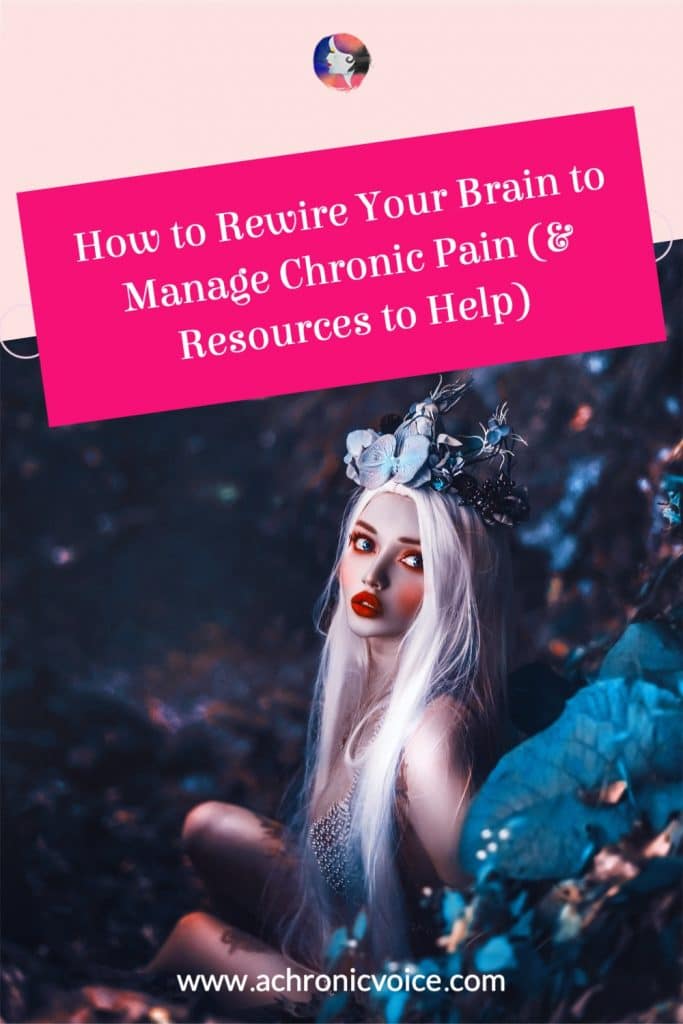
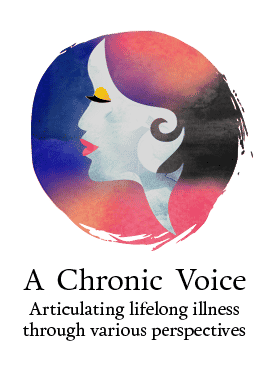
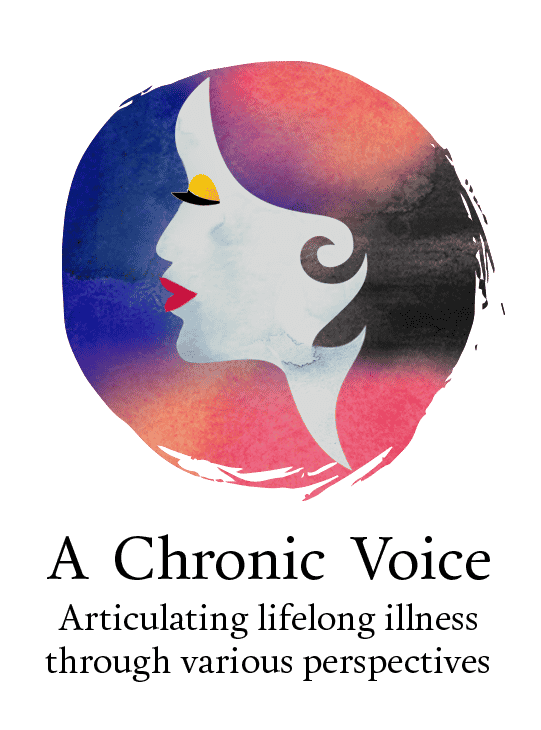

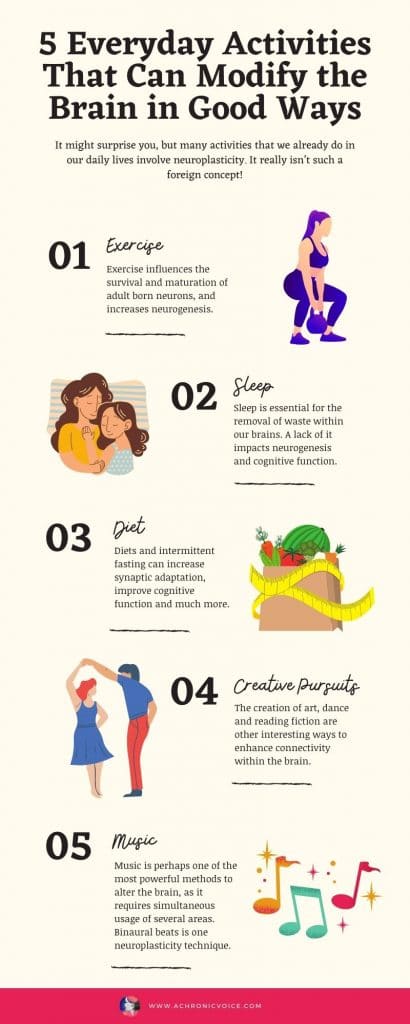
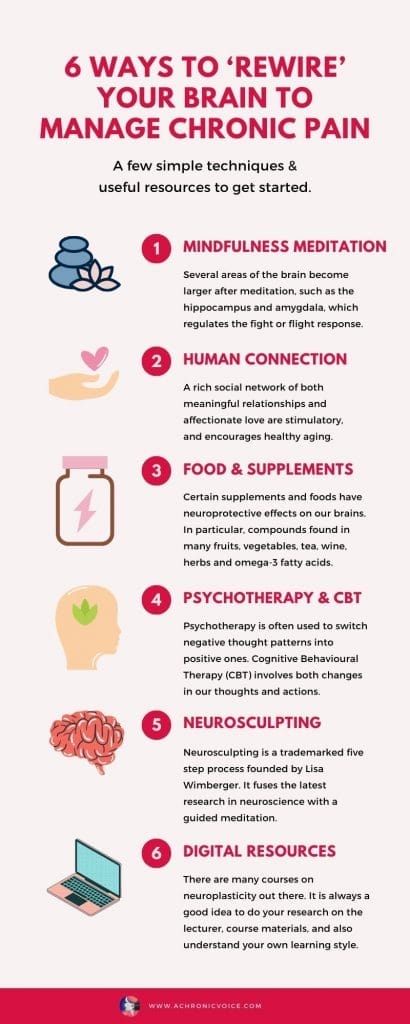
This is such a detailed post, thank you for all your research and efforts in putting it together. I incorporate neuroplasticity exercises and have found them beneficial but I never considered how other aspects of health like diet and human connection can enhance the benefits of them.
Thank you Lucy, for taking the time to read it! Yes I hope the research is as accurate as is possible on my end of things. Definitely – diet and social connection are SO important, too! I have an entire post about those too. Just do a search for ‘Dimensions of Wellness’ 😉 If it’s too long there’s audio too! 😀
Excellent in-depth post! I loved how you differentiated between chronic and acute pain. Neuroplasticity is such an interesting field and you did a great job explaining it. As someone with chronic pain from RA and Fibromyalgia, it’s nice to know there is hope. I’m going to look into mindfulness meditation as my psychologist just mentioned this too. I’m also hoping that some CBT will help too. I always love how informative your posts are. They’re super helpful and interesting.
Thank you so much for your kind words, Heather. I never knew you had RA and fibromyalgia. I hope this post helps a little and goodness knows I need to practice it more myself, too! 😉
As someone with fibromyalgia, so central sensitisation, I try and eat well and exercise (kind of failing at the sleep aspect . . . ) but I haven’t heard of neuro sculpting before. Thanks for sharing this, I will look into it further.
I cannot begin to imagine what it must be like for persons who suffer from chronic pain. I can well imagine that it must be tiring though. Sigh
Hi Mardene, it definitely isn’t easy one bit, but I think as human beings we learn to adapt in order to survive, and thrive with what we have where we are 🙂 Thank you for your empathy x
I know many that have cured their multiple chemical sensitivity with brain retraining. However, some of us won’t do the desensitization methods like sniffing Tide or Axe so wish you had a link to “There are medications and nerve treatments that work on our memories”. Lastly I had severe fibromyalgia and it went away when I cleaned my home of chemicals residue and someone I knew developed Parkinsons’ but was a big home use pesticide person. So neurotoxins like pesticides and perfumes are a factor especially if genes play a role and I want a balance between ‘head in the sand’ nothing can harm me and environmental health knowledge.
Hi Liz, thanks for your comment and feedback! I didn’t write anything about sniffing Tide or Axe, oh my, that doesn’t sound good! Cleaning your home of chemicals are definitely helpful, and also eating or using products that are ‘cleaner’ in and on our bodies. However, this post focuses on neuroplasticity, and not environment factors. That would be an entirely new topic on its own, which might be a good idea. Take care!
You’ve done lots of research for this, thank you for putting it together. I’m glad to have found the keto diet and various supplements as well as gentle movement to be best for my pain relief. Was on so much medication before that. Chronic pain is awful and there are so many types of pain too… Each requiring different treatments. Like my body needs heat for relief while my spine and head needs cold – sometimes simultaneously. So bizarre, isn’t it? Thanks again for all this great info x
Hi Char,
Thanks for taking the time to read and comment. Am glad you found that the keto diet worked for you! Yes I think it’s hard for people to understand that there are so many kinds of pains, with different approaches needed. It indeed is bizarre as it gets! x
I included a link to this blog post on my post about pain and the Pathways app on dSavannahRambles. Thank you for your thoughts!
Thank you so much! 😀
oh this post is amazing! I know several people that suffer from chronic pain and I am going to share your post with them!
Thank you Candice, your support means a great deal to me!
Such a welll done post!!! You’ve provided excellent information and resources for people with Chronic Pain…thank you so much for your thoughtfulness and care in presenting this.
Thanks Pamela! I hope it’s helpful and I learned a lot from researching this topic, too!